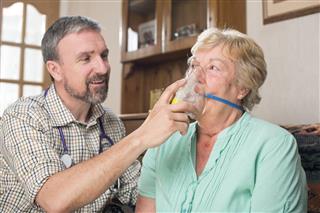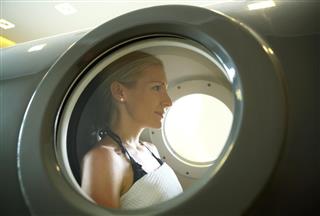
Oxygen therapy is recommended for patients suffering from low blood oxygen levels. This write-up provides information on the side effects associated with this therapy.
Oxygen therapy involves administering oxygen to people suffering from hypoxemia, which is a condition characterized by low blood oxygen levels. It is resorted to when the patient’s lungs fail to supply enough oxygen to the blood. The patient receives oxygen through compressed oxygen cylinders, liquid oxygen tanks, or oxygen concentrators which are connected to an oxygen mask or plastic tubes. Hyperbaric oxygen therapy is a comparatively newer method wherein the individual is placed in a pressurized chamber which contains almost 100% oxygen. This helps the body to absorb more oxygen than it does during normal conditions, thus activating the blood vessels and body cells.
Side Effects of Oxygen Therapy
Though oxygen therapy is considered to be safe, side effects have been reported. Most of the time, these side effects are very minor and do not last for a long time. Nevertheless, there have been cases (though very rare) where oxygen therapy has led to severe side effects.
- People who have undergone hyperbaric oxygen therapy have complained about experiencing nausea and fatigue after the treatment session. They may also experience temporary vision problems and sometimes slight difficulty in breathing after undergoing this therapy. Ear pain and sinus problem are also known to occur due to increased pressure in the oxygen chamber. However, these side effects are not permanent and do not stay for a long time.
- One of the serious side effects is oxygen toxicity which can cause pulmonary and central nervous system disorders as well as seizures. Some people have also reported to have experienced a feeling of claustrophobia in the oxygen chamber.
- It is a risky affair to administer high levels of oxygen to newborns as it may cause blindness. This happens due to the overgrowth of new blood vessels in the eye obstructing sight. This is called retinopathy of prematurity (ROP).
- Apart from this, severe effects can be experienced by people who have health problems, like asthma, upper respiratory tract infection, middle ear surgery, etc., and hence they should stay away from this treatment method. Even pregnant women should not be given this therapy as this can cause harm to the mother as well as to the fetus. Other than this, the condition of people who have high fever or some kind of viral fever may worsen due to oxygen therapy.
Precautionary Measures
Adverse effects associated with home oxygen therapy can be avoided to some extent by following certain precautionary measures.
- Handle the equipment with utmost care: Many times, due to improper handling of the equipment, the oxygen supply gets contaminated which can cause several health problems and possible death too. Also, if the filters are not cleaned or if the breathing tubes are not changed regularly, this can cause patients to inhale oxygen that is polluted by air-borne particles.
- Placement of the equipment: Another precautionary measure for people using home oxygen therapy is to keep the oxygen equipment at a distance not only from heat sources including gas stove, candle flame, etc., but also from hair sprays, aerosol cans, etc., as these are inflammable.
- Don’t alter the oxygen flow: At times, people use the equipment at home. Adverse effects may occur if the individual makes a mistake while altering the flow of oxygen by himself. This has to be avoided completely and if you think that the oxygen supply that you are getting is not adequate, your health professional should be contacted who in turn will inform the home care supplier to change the oxygen flow rate.
- Right Dosage: The dosage of oxygen that a person requires is determined by the doctor, according to his/her health condition. The dosage of oxygen that has to be given to an individual is determined based on the amount of oxygen required, the time required for the treatment and also the frequency in which the therapy has to be administered. Side effects may be due to wrong dosage.
These effects are very rare and most likely do not cause any permanent damage. However, being aware of the possible side effects will help individuals in preventing or controlling the causes that trigger them. One has to be very careful while handling this highly combustible oxidant, as concentrated oxygen catches fire very easily and this can lead to fatal accidents.
Disclaimer: This article is for informative purposes only, and does not in any way attempt to replace the advice offered by an expert on the subject.




